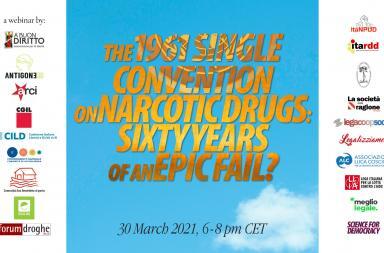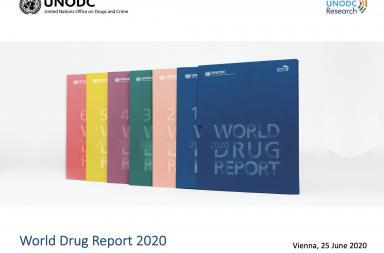This post is also available in:  Italiano (Italian)
Italiano (Italian)
On June 26 a coalition of Italian groups and associations released the 11.th edition of the White Paper on Drug Policy in Italy to mark the 2020 Global Day of Action for the Support Don’t Punish campaign. The White Paper is an annual independent report produced by La Società della Ragione with contribution from Forum Droghe, Antigone, CGIL, CNCA, Associazione Luca Coscioni, ARCI, LILA, Legacoopsociali and co-signed by A Buon Diritto, Comunità di San Benedetto al Porto, FP CGIL, Gruppo Abele, ITARDD, ITANPUD.
This White Paper provides a comprehensive set of 2019 data on the consequences of the war on drugs on the Italian criminal and jail systems, including specific figures about law enforcement actions and drug user habits. Also included is an overview of the effects of the COVID-19 crisis on prison situation and drug consumption. As in our previous editions, we also provide some general refelctions on local service systems, harm reduction implementation and drug policy reform at National and International level.
Main Trends and Statistics
The devastating effects of the 1990 drug law (Jervolino-Vassalli Act) on the National criminal and jail systems can no longer be dismissed as just “collateral damages”. This repressive and sanctioning law (particularly its Article 73, drug possession for the purpose of dealing) is undoubtedly the main gateway for our overcrowded justice and jail systems.
The current law on drug control is being used to increase the overall punitive measures. We should instead focus on decriminalizing people behavior when related to illegal drug circulation and on reforming zero-tolerance policies and compulsory social control based on their criminalization. To avoid this on-going prison overcrowding and its related problems, it would suffice to avoid jail sentences for non-violent crimes to Article 73 and/or for drug addicts, as indicated by our data simulations.
Out of 46,201 newly incarcerated people in 2019, 13,677 are accused or convicted of offences to that Article 73. This figure – 29.60% of new detainees – confirms a downward trend emerged since 2012, following the Torreggiani ruling by the ECHR and the adoption of deflationary policies. Today 34,80% of total detainees are in jail for infringements to the 1990 drug law.
On 31 December 2019, 14,475 out the total of over 60,000 detainees (23.82%) were charged only with dealing (Article 73). An additional 5,709 people (9.39%) were also charged with association aimed at illicit trafficking in drugs and psychotropic substances (Article 74), while an extra 963 detainees were charged only with Article 74 (1.58%). Compared to 2018, there is an unnoticeable decrease of 0.67%.
Today over 36% of those going to jail are drug users, while almost 28% (16,934) of current inmates are defined as “drug addicts”: the highest levels recorded in the last 15 years. In the last four years this trend saw a constant growth due an ongoing flow of addicts. In 2019 they accounted for 36.45% of total new detainees.
Pending criminal proceedings in violation of Article 73 and 74 include respectively 175,788 and 42,067 people: a slight decline if compared to the previous year, but still heavily affecting the entire judicial systems. Over 200,000 drug-related cases are still pending, with 1 out of 2 leading to a conviction. For crimes against a person or property the ratio is 1 to 10.
Alternative Measures and Administrative Sanctions
A positive trend is an ongoing application of “alternative measures”, especially useful for the drug rehab community and alcoholic inmates. However, this trend could suggest that such measures have become an alternative to freedom, not to detention, thus leading to stricter control techniques.
Denouncing people to local authorities (Prefect) for illicit drug use is also increasing: almost 44,000 case in 2019 (+6,67% compared to 2018) with only 202 requests for rehab program deferment (3,008 in 2007) and over 4,000 involving minors. This repressive trend affects for the vast majority cannabis users (77.95%), followed by cocaine (15.63 per cent) and heroin (4.62 per cent) users. Since 1990, there have been 1,312,180 of such reports at National level, almost a million just about marijuana users (73,28%).
While marijuana users are still the main target of law enforcement actions, according to unofficial 2019 data provided by Highway Patrol and ISTAT only 0.27% of drivers involved in road accidents during week-ends were accused of violating the Article 187 of the Road Code (driving under the influence of psychoactive drugs). For the first 10 months of 2019 the total cases rise up to 3.20%. It should be noted that test positivity often is not a definitive proof of DUI driving (especially for cannabis), thus conforming that overall drug use is not a major factor of car accidents in Italy.
Drug consumption and jail situation during the lockdown
The 2020 White Paper also covers the drug consumption and jail situation during the Covid-19 crisis. The initial results of three independent studies on drug consumption reveal that most consumer can keep their activity under control, resorting to new strategies to deal with this emergency, rapidly adapting to changing conditions for their life and consumption and minimizing health risks. The illegal drug market also showed flexibility and resilience, ever stopping to reach out and sustain user demand. Most public services have been able to adapt to this situation, even if once again in uneven fashion, by remodeling their pharmacological therapies, harm reduction tools, and online advice and information.
Finally, our White Paper provides an overview on the current status of drug policy reform at National and international level, along with specific insights on the jail situation, on minor criminal activities related to drugs, on health and assistance service reform – always under the perspective of substance use decriminalization.




